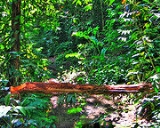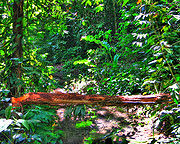
Pernambuco coastal forests
Encyclopedia
The Pernambuco coastal forests are a tropical moist broadleaf forest
ecoregion
of northeastern Brazil
, part of the larger Atlantic Forest region.
 The Pernambuco coastal forests occupy an 80 km-wide strip along the Atlantic
The Pernambuco coastal forests occupy an 80 km-wide strip along the Atlantic
coast of northeastern Brazil in the states of Pernambuco
and Alagoas
. The Goiana River
of Pernambuco marks the forests' northern extent, and the Mundaú River
of Alagoas the southern extent. The forests extend from near sea level to 600-800 meters elevation on the windward slopes of the Borborema Plateau
. The ecoregion is bounded on the east by the Atlantic Ocean
and the coastal Atlantic Coast restingas
forests and Rio Piranhas mangroves. To the east, the forests transition to the drier Pernambuco interior forests
and Caatinga
.
with annual rainfall ranging from 1,750 to 2,000 mm. There is a dry period from October through January.
(Alouatta belzebul) in the Atlantic Forests.
Tropical and subtropical moist broadleaf forests
Tropical and subtropical moist broadleaf forests , also known as tropical moist forests, are a tropical and subtropical forest biome....
ecoregion
Ecoregion
An ecoregion , sometimes called a bioregion, is an ecologically and geographically defined area that is smaller than an ecozone and larger than an ecosystem. Ecoregions cover relatively large areas of land or water, and contain characteristic, geographically distinct assemblages of natural...
of northeastern Brazil
Brazil
Brazil , officially the Federative Republic of Brazil , is the largest country in South America. It is the world's fifth largest country, both by geographical area and by population with over 192 million people...
, part of the larger Atlantic Forest region.
Setting

Atlantic Ocean
The Atlantic Ocean is the second-largest of the world's oceanic divisions. With a total area of about , it covers approximately 20% of the Earth's surface and about 26% of its water surface area...
coast of northeastern Brazil in the states of Pernambuco
Pernambuco
Pernambuco is a state of Brazil, located in the Northeast region of the country. To the north are the states of Paraíba and Ceará, to the west is Piauí, to the south are Alagoas and Bahia, and to the east is the Atlantic Ocean. There are about of beaches, some of the most beautiful in the...
and Alagoas
Alagoas
Alagoas is one of the 27 federative units of Brazil and is situated in the eastern part of the Northeast Region. It borders: Pernambuco ; Sergipe ; Bahia ; and the Atlantic Ocean . It occupies an area of 27,767 km², being slightly larger than Haiti...
. The Goiana River
Goiana River
The Goiana River is a river in Pernambuco state of northeastern Brazil. It is formed by the confluence of the Tracunhaém and Capibaribe Mirim rivers, and drains eastward into the Atlantic Ocean....
of Pernambuco marks the forests' northern extent, and the Mundaú River
Mundaú River
The Mundaú River is a river in northeastern Brazil. The Mundaú originates in the Borborema Plateau of Pernambuco state, and flows southeast through Pernambuco and Alagoas states to empty into the Mundaú Lagoon at Maceió, Alagoas' capital. Mundaú Lagoon is an estuary, connected to the Atlantic Ocean...
of Alagoas the southern extent. The forests extend from near sea level to 600-800 meters elevation on the windward slopes of the Borborema Plateau
Borborema Plateau
The Borborema Plateau is a plateau in northeastern Brazil which extends across the states of Pernambuco, Paraíba, and Rio Grande do Norte....
. The ecoregion is bounded on the east by the Atlantic Ocean
Atlantic Ocean
The Atlantic Ocean is the second-largest of the world's oceanic divisions. With a total area of about , it covers approximately 20% of the Earth's surface and about 26% of its water surface area...
and the coastal Atlantic Coast restingas
Atlantic Coast restingas
Atlantic Coast restingas are an ecoregion of Brazil, part of the Atlantic Forest region. Restingas are coastal forests which form on sandy, acidic, and nutrient-poor soils, and are characterized by medium sized trees and shrubs adapted to the dry and nutrient-poor conditions found...
forests and Rio Piranhas mangroves. To the east, the forests transition to the drier Pernambuco interior forests
Pernambuco interior forests
The Pernambuco interior forests is an ecoregion of eastern Brazil. It is part of the larger Atlantic forests complex, and lies between the coastal Pernambuco coastal forests and the dry Caatinga shrublands of Brazil's interior.-Setting:...
and Caatinga
Caatinga
Caatinga is a type of vegetation, and an ecoregion characterized by this vegetation in the northeastern part of Brazil. The name "Caatinga" is a Tupi word meaning "white forest" or "white vegetation"...
.
Climate
The ecoregion has a tropical climateTropical climate
A tropical climate is a climate of the tropics. In the Köppen climate classification it is a non-arid climate in which all twelve months have mean temperatures above...
with annual rainfall ranging from 1,750 to 2,000 mm. There is a dry period from October through January.
Fauna
The ecoregion is an endemic bird area that harbors 13 threatened species of birds. It also harbors the last populations of the Red-handed Howler MonkeyRed-handed Howler
The red-handed howler is a vulnerable species of howler monkey, a type of New World monkey. It is endemic to Brazil, where found in the south-eastern Amazon and disjunctly in Atlantic Forest between Rio Grande do Norte and Sergipe....
(Alouatta belzebul) in the Atlantic Forests.

